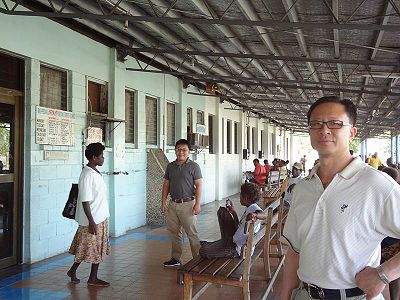Enews209 A Trip to Solomon Islands
出自KMU e-News
高雄醫學大學e快報 第209期 醫學院專題
A Trip to Solomon Islands
呼吸治療學系主任 周世華
With limited understanding of Solomon Islands (S.I.), I will only attempt to present a report of my observations after 3 weeks in Honiara for reference for future visitors. In this report I will mention only briefly the general living, health and educational conditions.
The capital, Honiara, has a population of approximately 100,000, with only one main road that runs along the coastline for use of the entire populace, hence problems with crowding, particularly during rush hour. Our residence is not far from the National Referral Hospital (NRH)- only ten minutes drive. Our quarters are quite comfortable, apart from the copious amounts of mosquitoes. The temperature is very high, up to 32 degrees C, but without the humidity we experience in Taiwan. No air conditioning was necessary during our stay. It becomes much cooler after sunset, and a blanket was used when sleeping.
The S.I. is economically immature (compared to Taiwan), rough estimate about 50 years behind. Some villages do not even have an electricity supply. However, costs of living are comparable to that of London, being twice or three times that of Kaohsiung. There doesn’t seem to be a reason to suggest why this is.
NRH is a relatively facilitated hospital in Honiara, thought there is still a severe shortage of medical staff. Many of the other islands have no doctors at all. Only serious cases with good prognosis are airlifted to NRH. otherwise… Though there is much aid from Japan, Australia, New Zealand, and WHO/NGO, there is still much to be done.
Classrooms in the schools are very poorly constructed, and there is also shortage of teachers. The learning atmosphere is not constructive, and positive student attitude has yet to be fostered. Annual fees are eighty Solomon dollars per student, but after holidays, many find reasons not to return to classes.
It would take much time and effort to improve these conditions.
This time, four students and I visited Visale Primary School and Chung Hwa School as teachers’ assistants. I also did volunteer medical service in the village at Visale. More or less, the trip was a success.
The volunteer medical students taught personal hygiene, played games with the children, and strengthened Chinese speaking and writing in the Chinese school. They did very well. After implementation of a few key points in order to further improve our service, much hope in the future that this tradition can be continued at KMU. They are as follows:
- Volunteer students should better be at a senior level, and have knowledge related to clinical medicine (eg. medical, dental, nursing, respiratory care, physio therapy, and public health). In particular, those medical students who are serving compulsory military service, if sent to the S.I. as bedside assistance at NRH would be of great help. These students can increase their field experience during their time in SI, particularly in an environment so lacking in diagnostic equipment. They can also provide local schools with messages of basic personal hygiene which can lead to decreased prevalence of contagious diseases.
- Education
Although the students did a successful job, in my opinion, the teaching of pre- and primary school should better be approached by the educationist. KMU being a university of medicine does not have a program in place for the training of such teachers. In order to improve our service, I suggest students majoring in early childhood education to be part of future volunteer teams.
Taiwanese people have very little understood of the SI, even unsure of its actual location. Many students expressing interest in the program would be pulled out because of parental opposition stemming from misunderstanding. This is possibly due to inadequate information from the government.
Because of financial shortage, funds must be appropriated accordingly and carefully.
Finally I have to thank KMU for her financial support so that we can have such an unforgettable and invaluable experience, seeing what was happening on the other side of the world. High appreciation is given to Team Leader Eddy Lin and supervisor Martin Hsiao for their help and suggestions contributing this amusing trip. Also, thank God for keeping us safe even coming across an earthquake of measuring 6.8 on the Richter scale.

